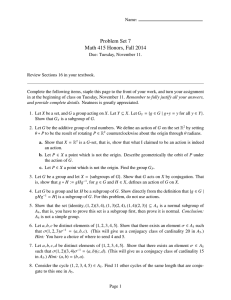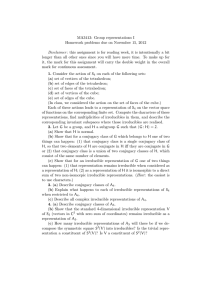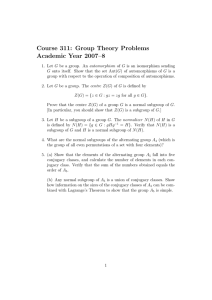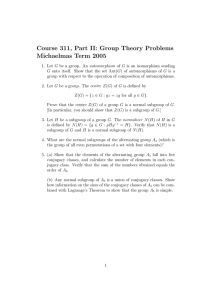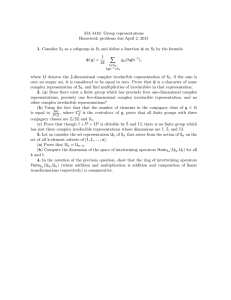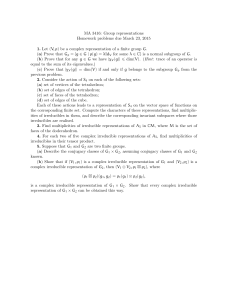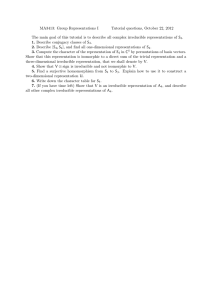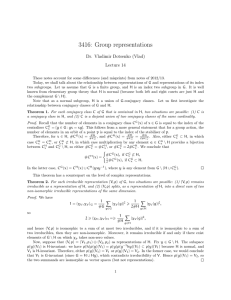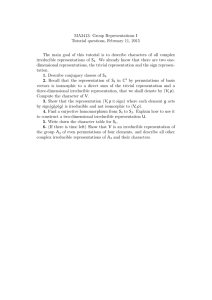Conjugacy of Subgroups of the General Linear Group Colva M. Roney-Dougal CONTENTS
advertisement
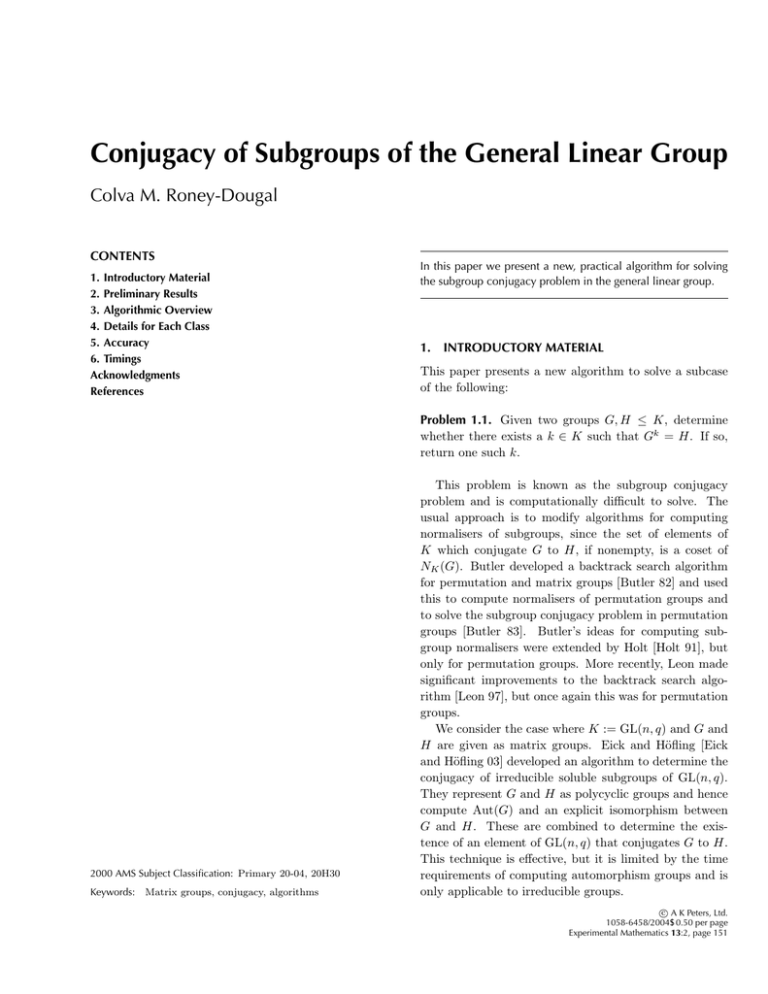
Conjugacy of Subgroups of the General Linear Group
Colva M. Roney-Dougal
CONTENTS
1. Introductory Material
2. Preliminary Results
3. Algorithmic Overview
4. Details for Each Class
5. Accuracy
6. Timings
Acknowledgments
References
In this paper we present a new, practical algorithm for solving
the subgroup conjugacy problem in the general linear group.
1.
INTRODUCTORY MATERIAL
This paper presents a new algorithm to solve a subcase
of the following:
Problem 1.1. Given two groups G, H ≤ K, determine
whether there exists a k ∈ K such that Gk = H. If so,
return one such k.
2000 AMS Subject Classification: Primary 20-04, 20H30
Keywords:
Matrix groups, conjugacy, algorithms
This problem is known as the subgroup conjugacy
problem and is computationally difficult to solve. The
usual approach is to modify algorithms for computing
normalisers of subgroups, since the set of elements of
K which conjugate G to H, if nonempty, is a coset of
NK (G). Butler developed a backtrack search algorithm
for permutation and matrix groups [Butler 82] and used
this to compute normalisers of permutation groups and
to solve the subgroup conjugacy problem in permutation
groups [Butler 83]. Butler’s ideas for computing subgroup normalisers were extended by Holt [Holt 91], but
only for permutation groups. More recently, Leon made
significant improvements to the backtrack search algorithm [Leon 97], but once again this was for permutation
groups.
We consider the case where K := GL(n, q) and G and
H are given as matrix groups. Eick and Höfling [Eick
and Höfling 03] developed an algorithm to determine the
conjugacy of irreducible soluble subgroups of GL(n, q).
They represent G and H as polycyclic groups and hence
compute Aut(G) and an explicit isomorphism between
G and H. These are combined to determine the existence of an element of GL(n, q) that conjugates G to H.
This technique is effective, but it is limited by the time
requirements of computing automorphism groups and is
only applicable to irreducible groups.
c A K Peters, Ltd.
1058-6458/2004$ 0.50 per page
Experimental Mathematics 13:2, page 151
152
Experimental Mathematics, Vol. 13 (2004), No. 2
Our algorithm uses Aschbacher’s theorem [Aschbacher
84] to reduce the time spent searching for a conjugating element: its primary goal is to prove that G and H
are conjugate, although we present some ideas on how
to prove that they are not. It is applicable to geometric subgroups of GL(n, q). The approach is to use the
geometries described in Aschbacher’s theorem to find
A, B ∈ GL(n, q) such that GA and H B are contained
in a given maximal subgroup C ≤ GL(n, q). Standard
conjugacy techniques (for permutation groups) are then
used to try to find an element of C that conjugates GA
to H B . Whilst there is not always a guarantee that such
an element exists, experiments show that generally one
does; for some of the Aschbacher classes, we prove that
one can be found whenever G and H are conjugate in the
general linear group.
The development of this algorithm was motivated by
the observation that determining the conjugacy of subgroups of GL(6, 3) often required several days of computing time. Although the methods described in this paper
will not always succeed either in finding a conjugating
element or in proving that G and H are not conjugate,
they are useful because they can often solve the conjugacy problem inside general linear groups that were far
too large for previous approaches. The timings data in
Section 6 demonstrates this.
An implementation of this algorithm will be released
with Version 2.11 of Magma [Bosma et al. 97].
At present the algorithm only works to determine conjugacy under the general linear group. There are several
directions in which it could be generalised. The most obvious is to make it work inside any classical matrix group.
The biggest problem will be the construction of the relevant maximal subgroups, but recent work of Holt and the
author [Holt and Roney-Dougal] gives generating matrices for most of these groups in the linear, symplectic, and
unitary cases.
The algorithm could perhaps be made faster by making certain sections of it recursive. Aschbacher’s theorem
is used to find a maximal subgroup C ≤ GL(n, q) and two
matrices A, B ∈ GL(n, q) such that GA , H B ≤ C. For
many of the Aschbacher classes, it should be possible to
recursively apply Aschbacher’s theorem to part or all of
the group C, to construct A , B ∈ C and a maximal sub
group C ≤ C such that GAA , H BB ≤ C , and then to
search C for a conjugating element. We write H ∼K G
to denote that H is conjugate to G under K. The cost
of this recursive approach is that it seems intuitively less
likely that GAA ∼C H BB than that GA ∼C H B ; however, the time gains of computing conjugacy inside a
smaller group, with a smaller degree permutation representation, would probably outweigh this.
In Section 2 we make some key definitions, state Aschbacher’s theorem, and prove a few elementary results.
In Section 3 we give an overview of our algorithm for
determining the conjugacy of geometric matrix groups,
and then in Section 4 we describe how it works in each
geometric Aschbacher class. In Section 5 we discuss the
accuracy and reliability of the algorithm and conclude in
Section 6 with timings data.
2.
PRELIMINARY RESULTS
We now recall some basic mathematical definitions, prove
a few fundamental lemmas, and state Aschbacher’s theorem.
(n)
Let G ≤ GL(n, q) be given, and set V := Fq . Then G
is reducible if it stabilises a proper nontrivial subspace of
V , and is irreducible otherwise. If the image of G under
the natural embedding into GL(n, F) is irreducible for all
field extensions F of Fq , then G is absolutely irreducible. If
G is irreducible and preserves a direct sum decomposition
V = V1 ⊕ · · · ⊕ Vt with t > 1, then G is imprimitive.
Theorem 2.1. (Aschbacher’s Theorem [Aschbacher 84].)
Let G ≤ GL(n, q) be given, let q = pe , let V := Fnq , and
let Z := Z(GL(n, q)). Then one of the following holds:
1. G is reducible.
2. G is imprimitive.
3. G can be embedded in ΓL(n/s, q s ) for some prime s
dividing n.
4. G preserves a tensor product V = V1 ⊗ V2 , where
dim V1 = dim V2 .
5. A conjugate of G is a subgroup of GL(n, pf )Z, where
e/f is prime.
6. The dimension n = rm , where r is prime. If r is odd
or n = 2, then r divides q − 1, and G normalises an
extraspecial r-group. Otherwise, 4 divides q − 1, and
G normalises a 2-group of symplectic type.
7. G preserves a tensor induced decomposition V =
V1 ⊗ · · · ⊗ Vt with t > 1.
8. G lies between a classical group and its normaliser in
GL(n, q), or preserves a classical form up to scalar
multiplication.
9. For some nonabelian simple group T , the group
G/(G ∩ Z) is almost simple with socle T . In this
Roney-Dougal: Conjugacy of Subgroups of the General Linear Group
case the normal subgroup (G ∩ Z) .T acts absolutely irreducibly, preserves no nondegenerate classical form, is not a subfield group, and does not contain SL(n, q).
The original theorem describes subgroups of all classical groups: see [Aschbacher 84].
We follow the notation of [Kleidman and Liebeck 90]
when naming classical groups. In particular O (n, q),
where is +, −, or omitted, denotes the largest subgroup of GL(n, q) to preserve a quadratic form of type .
The groups GSp(n, q) and GO (n, q) are the normalisers
in GL(n, q) of Sp(n, q) and O (n, q).
A group G ≤ GL(n, q) lies in class Ci if the ith condition of the theorem holds, and G is geometric if G ∈ Ci
for some i ≤ 8. The class Ci is recognisable for G if
there exist algorithms to recognise that G ∈ Ci . Let G
be any geometric group other than a member of C8 that
does not fix a classical form (up to scalar multiplication),
then, G can be recognised as being a member of at least
one Aschbacher class: more details will be given later.
A matrix group G is AS-maximal if G is a maximal
member of an Aschbacher class. Aschbacher proved a
theorem that may be informally stated by saying that,
with the exception of reducible AS-maximals that are
conjugate under the duality automorphism, the geometric AS-maximals of a given type are all conjugate under
the general linear group [Aschbacher 84, Theorem B∆].
An AS-overgroup for a geometric group G is an ASmaximal that preserves a structure of the same type
as G: constructions for canonical AS-overgroups will be
given later. If G has been conjugated into a given ASovergroup, then G has been standardised (with respect
to that AS-overgroup).
We finish with some algorithmic preliminaries. We assume that integer operations require constant time. We
also assume that primitive polynomials are known for all
finite fields that we encounter and that elements of Fpe
are stored as polynomials of degree e − 1 over Fp . Thus,
field operations require time O(log q), and elements of
GL(n, q) are constructed in O(n2 log q). We assume that
matrix multiplication is O(n3 log q) and that primitive
field elements are known. We will not assume the availability of discrete logs. By constructing a group we mean
producing a set of generating elements for the group: usually these will be a collection of matrices.
Lemma 2.2. Given a primitive element z ∈ F∗q , the
groups GL(n, q), SL(n, q) and Sp(n, q) can be constructed
153
in time O(n2 log q). The groups GU(n, q) and SU(n, q)
can be constructed in time O(n2 log q + log2 q).
Proof: Pairs of generating matrices are known for
GL(n, q), SL(n, q), Sp(n, q), GU(n, q), and SU(n, q) [Taylor 87]. In the linear and symplectic cases, all coefficients
lie in the set S := {0, ±1, ±z ±1 }. All coefficients in the
unitary case lie in T := S ∪ {±z ±p , ±(1 + z p−1 )−1 }. The
set S can be constructed in O(log q), and T can be constructed in O(log2 q).
If D = (dij )n×n is diagonal, we write D =
Diag[d11 , d22 , . . . , dnn ]. If dij = 0 unless j = n − i + 1,
we write D = AntiDiag[d1n , d2(n−1) , . . . , dn1 ]. When
generated as in Lemma 2.2, Sp(d, q) preserves a form
AntiDiag[1, . . . , 1, −1, . . . , −1], and GU(d, q) preserves a
form AntiDiag[1, . . . , 1]. For odd q we assume that
SO(2m+1, q) preserves a form with matrix I2m+1 . When
q is odd, we assume that SO± (2m, q) preserves an orthogonal form with matrix Diag[z, 1, . . . , 1] or I2m , depending on whether (q − 1)n/4 is even or odd. For even q
we assume that the orthogonal groups of + and − type
preserve the form given by Magma.
Lemma 2.3. There is a Las Vegas O(log3 q) algorithm
that, with probability of success 1/2, finds a, b ∈ Fq such
that a2 + b2 = z.
Proof: Search F∗q for an element b such that z − b2 is a
square. At least half of the field elements are squares, and
each test of squareness costs O(log3 q) [Lidl and Niederreiter 83].
Lemma 2.4. For ∈ {+, −, ◦}, the groups Ω (n, q),
SO (n, q), O (n, q), and GO (n, q) may be constructed
in time O(n3 log q + log3 q).
Proof: Let S := {0, 1, z, ν, ν}, where ν = F∗q2 . The set
S can be constructed in time O(log2 q). In [Rylands and
Taylor 98] small sets of generating matrices are given for
Ω (n, q), which can be constructed in time O(n2 log q),
given S.
Let S extend Ω (n, q) to SO (n, q), if these groups are
not equal. Let Rs be a reflection in a vector of square
norm and Rn be a reflection in a vector of nonsquare
norm: Rs and Rn can be constructed in time O(n2 log q).
By [Kleidman and Liebeck 90, Sections 2.6–2.8], we may
take S := −I if n is even, q is odd, and the discriminant
of the form is nonsquare; S := Rs Rn if n is odd or n is
even, q is odd, and the discriminant is square; or S := Rs
154
Experimental Mathematics, Vol. 13 (2004), No. 2
if n and q are both even. Thus, we construct S in time
O(n3 log q).
Let T extend SO (n, q) to O (n, q), if these groups
are not equal. By [Kleidman and Liebeck 90, Sections
2.6–2.8], we may take T := Rs if n is even and q is odd,
and T◦ := −I if q is odd, in time O(n2 log q).
Let D extend O (n, q) to GO (n, q). Assume that the
quadratic form has matrix AntiDiag[1, . . . , 1] in type +
and either the identity or Diag[z, 1, . . . , 1] in type −: a
matrix conjugating our original group to one preserving
this form can be constructed in time O(n3 log q) [Holt
and Roney-Dougal]. Then D := zIn if n is odd or q is
even. If q is odd, then D+ := Diag[z, . . . , z, 1, . . . , 1] and
D− := Diag[P, . . . , P ] or Diag[AntiDiag[z, 1], P, . . . , P ],
depending on whether the discriminant of the form is
square or nonsquare, where a and b are as in Lemma 2.3
and
a b
P :=
.
b −a
Lemma 2.5. Given a set S of generating matrices
for G ≤ GL(n, q) and a set T of generating permutations for H ≤ Sym(d), a set of generating matrices for G H ≤ GL(nd, q) can be constructed in time
O((|S| + |T |)(nd)2 log q).
Proof: For each generating matrix X ∈ S, define a matrix
Diag[X, In , . . . , In ]. For each Y ∈ T , define an nd × nd
block matrix whose (i, j)th block is In , if Y maps i → j,
and 0 otherwise. The group G H is generated by these
(|S| + |T |) matrices.
Let G ≤ GL(n, q) and H ≤ GL(m, q). By G ⊗ H
we mean a group isomorphic to (G × H)/
(x, x−1 ) : x ∈
G ∩ H ∩ Z(GL(nm, q)). Note that if G and H are absolutely irreducible, then this reduces to the standard
central product G ◦ H. The group G ⊗ H has a natural
(n)
(m)
action on Fq ⊗ Fq .
By HTensWrK, where H ≤ GL(n, q) and K ≤ Sym(t)
is transitive, we mean the subgroup of GL(nt , q) given by
(H ⊗ · · · ⊗ H) : K.
The group K permutes the factors in the central product.
Lemma 2.6. Let G := S ≤ GL(n, q) and H :=
T ≤ GL(m, q). The group G ⊗ H ≤ GL(mn, q)
can be constructed in O((|S| + |T |)(mn)2 log q), and
GTensWr Sym(t) can be constructed in O(|S|n2t log q).
Proof: The group G ⊗ H is generated by the Kronecker products of elements of S with 1H and of 1G
with elements of T . Given X ≤ G and Y ≤ H,
the Kronecker product X ⊗ Y has Xij Ykl in position
((i − 1)m + k, (j − 1)m + l). Each matrix is therefore
written down in time O((mn)2 log q).
The final claim is from [Holt and Roney-Dougal].
3.
ALGORITHMIC OVERVIEW
We give a description of the algorithm for geometric
groups, which is then specialised for each Aschbacher
class.
IsGLConjugate(G, H)
1. Input: G, H ≤ GL(n, q).
2. If G = H, return true. If not then compute several
group-theoretic invariants of G and H. If these are
different, return false.
3. Replace G and H by random GL(n, q)-conjugates.
4. For each Ci = C9 to which G can be recognised as
belonging:
(a) Identify a structure S that G preserves, construct an AS-overgroup C for G, and find A ∈
GL(n, q) that standardises G.
(b) If H can be shown not to preserve a structure
isomorphic to S, then return false.
(c) Form a faithful representation ρ of C.
(d) For at least one structure isomorphic to S that
is preserved by H do:
i. Find B ∈ GL(n, q) which standardises H.
ii. Use an existing conjugacy algorithm for
permutation groups to decide whether
there exists an Xρ ∈ Cρ such that
(GA )ρXρ = (H B )ρ.
iii. If so, return true, AXB −1 . If not, and
i = 6, then return false.
(e) If i ∈ {1, 8} return false.
5. Return unknown
In Step 2, various invariants are computed for G and
H, including their orders and their orbit lengths on vectors, and 1- and 2-spaces. If they are not soluble, then
we compute their soluble radicals and apply the same
comparisons to them. If G and H are small and soluble,
then we compute their conjugacy classes and check that
there is a bijection between them that preserves class
sizes and the characteristic polynomials of the class representatives.
Roney-Dougal: Conjugacy of Subgroups of the General Linear Group
In Step 3, we replace G and H by random conjugates.
This is to ensure that if unknown is returned and the
algorithm is run again, then different behaviour will be
displayed.
The behaviour of the algorithm at Step 4(d) depends
on the Aschbacher class Ci . For instance, in class C1
we can find all appropriate structures, up to the action
of H. However, in other classes this is not so: in the
imprimitive case, for instance, we can specify the block
size that we require, but beyond this there is no control
over what structures we find. This will be discussed on
a case-by-case basis in Section 4.
If G ∼GL(n,q) H, there are two ways that unknown
may be returned. Type 1 failure occurs when, for each
identifiable Aschbacher class for G and H, no matching
structures can be found for the loop 4(d). Type 2 failure is when, for each identifiable class for G and for each
standardising matrix that is tested for H, the standardised copies of G and H are not conjugate in their ASovergroup in Step 4(d)ii. We will discuss the probability
of these failures in Section 5.
If G ∼GL(n,q) H, then unknown is returned if G and H
pass the invariant tests of Step 2 of the main algorithm,
lie in the same Aschbacher classes, and cannot be shown
to preserve structures of different types: in practice this
almost never happens.
4.
DETAILS FOR EACH CLASS
For 1 ≤ i ≤ 8, we now describe how to recognise that a
group is in Ci , how to construct canonical AS-overgroups,
and how to standardise groups in Ci . In classes C1 and
C8 , we show that it is possible to return false in Step
4(e), and in C6 we show that one may return false in
Step 4(d)iii.
Let {ei : 1 ≤ i ≤ n} be the standard basis for
(n)
V := Fq .
4.1
Reducible Groups
Meataxe-based techniques can recognise that G is reducible [Holt and Rees 94], in time polynomial in n and
log q.
Let G ≤ GL(n, q), and let M and N be G-modules
over Fq . By HomF[G] (M, N ) we denote the subspace
of HomFq (M, N ) consisting of all homomorphisms that
commute with the action of F[G], where F is a splitting
field for N . The map φ ∈ HomFq (M, N ) is an isomorphism of G-modules if φ is invertible and for all v ∈ M
and g ∈ G we have (vg)φ = (vφ)g. The constituents
of a G-module M are representatives of G-isomorphism
155
classes of composition factors of M . The multiplicity of
a constituent C is the number of composition factors of
MG that are isomorphic, as G-modules, to C.
Proposition 4.1. Suppose G, H ≤ GL(n, q) have beeen
recognised as reducible. Then an AS-overgroup C can
be constructed in time O(n2 log q). In time polynomial
in n and log q, a standardising matrix A for G and a list
MH of standardising matrices for H may be constructed,
where |MH | ≤ n.
Proof: Let MG be the natural G-module. We start by
identifying a submodule W of MG , which we will use to
determine the type of AS-overgroup to construct and to
standardise G. We will denote the dimension of W by d.
We use the algorithms of [Cannon et al., Section 4] to
form a set IG of constituents of MG , in time polynomial
in n and log q. If some of the constituents in IG have
multiplicity 1 and a nontrivial image in MG (so that they
correspond to irreducible submodules of MG ), then we
select one of these, of dimension as close as possible to
n/2, and let W be its image in MG .
Otherwise, if all constituents of multiplicity 1 do not
correspond to submodules of MG , there are two possibilities. If there exists a constituent ∆ of dimension e
such that HomF[G] (∆, MG ) has dimension k and ke < n,
then we let W be the submodule of MG generated by the
images of a basis of HomF[G] (∆, MG ), under the natural
inclusion map into MG . This is a proper submodule of
MG , of dimension d = ke.
If no such constituent ∆ exists, then we let W be any
irreducible submodule of MG (all irreducible submodules
of MG are G-module isomorphic to W ) and let d denote
the dimension of W .
We create an AS-overgroup M (n, d, q) that is the stabiliser in GL(n, q) of en−d+1 , . . . , en , in time O(n2 log q)
by [Holt and Roney-Dougal].
Let X ∈ GL(n, q) have as rows the basis vectors of a
complement of W in Fnq followed by a basis for W , and
put A := X −1 . All matrices in GA have a (d × (n −
d)) block of zeros in the bottom left corner, so GA ≤
M (n, d, q).
Next we turn to H: we aim to construct a list JH of
suitable representatives of the d-dimensional submodules
of the natural H-module, MH . We again use [Cannon et
al., Section 4] to compute the set IH of constituents of
MH .
If W is the image of a constituent of multiplicity 1 and
MH does not have at least one constituent of multiplicity
1 and dimension d, then G ∼GL(n,q) H. For each U ∈ IH
156
Experimental Mathematics, Vol. 13 (2004), No. 2
of multiplicity 1 and dimension d, we let BU be a basis for
HomF[H] (U, MH ). For V ∈ BU we append ImV , viewed
as a submodule of MH , to JH .
If W is the image in MG of k composition factors of
MG , then if MH does not have at least one constituent of
dimension e and multiplicity k, then G ∼GL(n,q) H. For
each such constituent we append a submodule S to JH ,
constructed in the same way as W .
Finally, if W is one possible image in MG of a constituent C of multiplicity k and dimension d = n/k, then
if MH does not also have a single constituent C of multiplicity k and dimension d, then G ∼GL(n,q) H. Let B be a
basis of HomF[H] (C, MH ), and let JH contain the image
of a single V ∈ B, considered as a submodule of MH .
Note that |JH | ≤ n/d, since there is at most one element of JH for each composition factor of MH . For each
S ∈ JH , we define a change of basis matrix YS , in the
same way as we formed X for G, and let BS := YS−1 . Let
MH := {BS : S ∈ JH }, then for each BS ∈ MH , we
have H BS ≤ M (n, d, q), so each BS standardises H.
The following theorem shows that we can return false
in Step 4(e) of the main algorithm, since the loop in Step
4(d) may be made to consider all submodules in JH .
Theorem 4.2. We have G ∼GL(n,q) H if and only if there
exists B ∈ MH with GA ∼M (n,d,q) H B .
Proof: One direction is clear, we prove the converse.
Suppose without loss of generality that G ≤
M (n, d, q), so that A = 1. Let E ∈ GL(n, q) conjugate G
to H. We wish to show that there exists B ∈ MH and
−1
X ∈ M (n, d, q) such that GXB = H.
Suppose first that W is an irreducible submodule that
is isomorphic to a unique composition factor of MG .
Then, for some T ∈ JH , we have T E = W . Now,
M (n, d, q) contains all elements of GL(n, q) fixing W ,
and W BT = T . Thus the coset M (n, d, q)BT−1 contains all elements of GL(n, q) mapping T to W , and so
E ∈ M (n, d, q)BT−1 .
Next suppose that W is a ke-dimensional reducible
submodule of MG , generated by k isomorphic irreducible
submodules, each of dimension e. Then, JH will consist of all ke-dimensional submodules of MH that are
generated by sets of k pairwise isomorphic irreducible edimensional submodules. Thus, for some T ∈ JH , we
must have T E = W , and the argument is identical to
the previous case.
Finally, suppose that W is an irreducible submodule
of MG and that MG has a basis consisting of submodules
isomorphic to W . Then, since G ∼GL(n,q) H, the set JH
consists of a single submodule T , chosen from a basis of
isomorphic submodules for MH . Now, NGL(n,q) (G) can
map any such basis of submodules for MG to any other,
and hence there exists at least one D ∈ NGL(n,q) (G) such
that GDE = H and T (DE) = W . The result then follows
as in case 1.
One alternative to Proposition 4.1 is to match up the
entire composition series of V under G with the composition series of V under H and to then look for a conjugating element inside the maximal subgroup of GL(n, q)
to preserve this composition series. This may often be
faster in practice, but multiplies the complexity by n!.
4.2 Imprimitive Groups
The AS-maximals in C2 are isomorphic to GL(m, q) Sym(t), where mt = n and t > 1. A recognition algorithm for absolutely irreducible imprimitive groups is
given in [Holt et al. 96a], which also returns a set BG
of blocks for G. The algorithm can be made to look for
blocks of a specific dimension, so the conjugacy algorithm
returns false at Step 4(b) if no blocks of the correct dimension exist. No further choices can be specified by the
user, so the loop in Step 4(d) is repeated up to 20 times,
replacing H by a random conjugate each time.
Lemma 4.3. Suppose that G has been recognised as C2 .
An AS-overgroup can be constructed in time O(n2 log q)
and G can be standardised in O(n3 log q).
Proof: Let BG := {V1 , . . . , Vt }. The AS-overgroup
GL(m, q) Sym(t) is constructed in O(t + m2 log q +
n2 log q) = O(n2 log q), by Lemmas 2.2 and 2.5.
To standardise, let A be a matrix whose ((i−1)m+1)th to im-th rows are a set of basis vectors of Vi , for
1 ≤ i ≤ t. Then the i-th block of imprimitivity preserved
−1
−1
by GA is Vi A−1 = e(i−1)m+1 , . . . , eim , so GA ≤ C.
4.3 Superfield Groups
Definition 4.4. A group G ≤ GL(n, q) is a superfield
group of degree s if for some s|n with s > 1 the group G
may be embedded in ΓL(n/s, q s ).
The AS-maximals in C3 are isomorphic to ΓL(n/s, q s ),
for each prime divisor s of n. If G is not absolutely
irreducible, then this can be recognised by an algorithm
of Holt and Rees [Holt and Rees 94]. If G ∈ C3 \ C2
Roney-Dougal: Conjugacy of Subgroups of the General Linear Group
is absolutely irreducible, then this can be recognised by
Smash [Holt et al. 96b]. Both algorithms also return s
and a centralising matrix ZG ∈ GL(n, q). This has order
dividing q s − 1 but not q i − 1, for i < s, and centralises
a normal subgroup of G, which is maximal, subject to
being conjugate to a subgroup of GL(n/s, q s ).
If G is not absolutely irreducible, then the recognition
algorithm will correctly identify the degree of the field extension; thus the conjugacy algorithm can return false
in Step 4(b) if the degrees do not match or if one group
is absolutely irreducible and the other is not. However,
if both groups are absolutely irreducible, then there may
be several different choices of normal subgroup that can
be embedded in GL(n/s, q s ), so the loop in Step 4(d) is
run up to 20 times, replacing H by a random conjugate
each time.
In the following proposition, let φ(n) denote Euler’s
phi function.
Proposition 4.5. Let s be a prime divisor of n, and
suppose that G has been recognised as semilinear of degree s. An AS-overgroup for G may be constructed in
time O(n2 log q + log2 q). Ignoring the time required
for integer factorisation, G can be standardised in time
O(φ(q s − 1)n4 log q + n3 log q log log q n ).
Proof: The first claim follows from [Holt and RoneyDougal].
Let ZC and ZG be centralising matrices for C and G,
respectively. We may assume that |ZC | = q s − 1, as ZC
is known explicitly, see [Holt and Roney-Dougal].
We use [Cellar and Leedham-Green 97] to compute
|ZG | in time O(n3 log q log log q n ): the order is a divisor
a
.
of q s − 1. Let a := (q s − 1)/|ZG |, and set S := ZC
i
We search ZG for an element ZG similar to S, in time
O(n4 log q) for each test. Functions to determine similarity of matrices also return a change of basis matrix, A.
−1
−1
has centralising matrix S, so GA
≤
Then GA
NGL(n,q) (
S) = C.
This has worse complexity than any other Aschbacher
class except C6 . If d = s, there is an alternative approach
for standardisation. Since |ZG | divides q s − 1, the group
ZG acts reducibly on V , as does S. We know that
ZG ∼GL(n,q) S. Therefore, we may use the conjugacy
algorithm from Section 3 to standardise G.
If d = s and φ(q s − 1) is large, then the algorithm of
Proposition 4.5 may take a while to find a standardising element. However, the AS-overgroup in this case is
ΓL(1, q d ), so the final conjugacy check is fast.
157
4.4 Groups Normalising an Extraspecial Group
Definition 4.6. A group G ≤ GL(n, q) is of extraspecial
type if G is absolutely irreducible and one of the following
is true:
• n = rm for an odd prime r with q ≡ 1 mod r, and
r1+2m G ≤ r1+2m . Sp(2m, r).
• n = 2m , q ≡ 1 mod 4, and 21+2m
≤ G ≤
(4 ◦ 21+2m ) . Sp(2m, 2), where ∈ {+, −}.
−
• n = 2, q ≡ 3 mod 4 and G = 21+2
− .O (2, 2).
We write the AS-maximal as C := P .N , where P is
the extraspecial normal subgroup.
An algorithm is given in [Holt et al. 96b] to determine
whether an absolutely irreducible group G is of extraspecial type. If it succeeds, then it returns an extraspecial
or symplectic-type r-group PG G, with |PG | ≥ r1+2m .
The following lemma will be used to standardise the
extraspecial groups.
Lemma 4.7. Let E1 , E2 ≤ GL(n, q) be extraspecial or of
symplectic type, of order r1+2m or 22+2m , let CI be an
imprimitive AS-overgroup for E1 and E2 , and suppose
that E1A , E2B ≤ CI . Then E1 ∼GL(n,q) E2 if and only if
E1A ∼CI E2B .
Proof: One direction is clear; we prove the converse. For
i ∈ {1, 2}, let Ni be such that Ei .Ni = NGL(n,q) (Ei ),
and suppose that X ∈ GL(n, q) is such that E1X = E2 .
Then, E1Y = E2 for all Y ∈ (E1 .N1 )X.
Since all AS-maximals in C6 are GL(n, q)-conjugate
[Aschbacher 84, Theorem B∆], the same is true for all
extraspecial subgroups of order r1+2m or 22+2m that are
of the same type. In particular, any extraspecial group
is GL-conjugate to one consisting of monomial matrices,
since there is a well-known monomial construction for
such extraspecial groups.
We may therefore suppose, without loss of generality,
that A = B = In , so that E1 preserves a decomposition
V := e1 ⊕ · · · ⊕ en and let CI := GL(1, q) Sym(n).
Let K1 be the kernel of the action of E1 on the set S :=
{
ei : 1 ≤ i ≤ n}, and let K1 be the kernel of the action
of E2 on S. Note that |K1 | = r1+m or 22+m . Now, E2
has several elementary abelian normal subgroups of order
r1+m (or 22+m ), and K1X is not necessarily equal to K1 .
Denote the set of elementary abelian normal subgroups
of order r1+m (or 22+m ) in Ei by Ki .
The groups in Ki are all conjugate under the action of
Ni , as they correspond to maximal isotropic subspaces
158
Experimental Mathematics, Vol. 13 (2004), No. 2
of P/Z(P ). The set of images {K1Q : Q ∈ (E1 .N1 )X} =
{K1Q : Q ∈ N1 }X = K1X = K2 . Thus, there exists an
element Y ∈ (E1 .N1 )X such that K1Y = K1 . Now, K1
fixes ei , for 1 ≤ i ≤ n, and so does K1 . Therefore,
Y ∈ CI and E1Y = E1X = E2 , as required.
Proposition 4.8. Suppose that G has been recognised as
an extraspecial normaliser. An AS-overgroup for G may
be constructed in time O(n3 log q). The group G may be
standardised in the time required to solve the conjugacy
problem for imprimitive matrix groups, as described in
Section 4.1. Furthermore, this use of the algorithm in
Section 4.1 is guaranteed to return true and a conjugating element.
Proof: An AS-overgroup C = P.N may be constructed
in time O(n3 log q) [Holt and Roney-Dougal].
Since G has been recognised as of extraspecial type,
an extraspecial or symplectic-type r-group PG G has
been identified. The group P ≤ C consists of monomial
matrices and hence is a subgroup of GL(1, q) Sym(n).
If |PG | = |P |, then we set P2 := PG . Otherwise |PG | =
|P |/2, and we set P2 := µIn , PG , where µ is a primitive
fourth root of unity in Fq . We use the imprimitive case of
IsGLConjugate(P 2,P) to find an element A such that
P2A = P . Then, GA ≤ NGL(n,q) (P2A ) = C.
The final statement follows from Lemma 4.7.
The following proposition implies that for C6 we may
return false in Step 4(d)iii of IsGLConjugate.
Proposition 4.9. Let G and H be of extraspecial type, and
suppose that C is an extraspecial AS-overgroup for G and
H and that GA , H B ≤ C. Then GA ∼C H B if and only
if G ∼GL(n,q) H.
Proof: If |PG | = |P |, then PGA = P is the unique normal
subgroup of both GA and H B of order |P |. Therefore, if
GX = H, then X ∈ NGL(n,q) (P ) = C.
So suppose that |PG | = |PH | = 21+2m . We may assume without loss of generality that A = B = In , so that
G, H ≤ C. Suppose that there exists X ∈ GL(n, q) such
that GX = H, and let G = PG .NG , H = PH .NH , and
C = P .N , with |P | = 22+2m .
All groups of order 21+2m that are of the same type as
PG are conjugate in C. Therefore, there exists an element
Y ∈ C such that (PGX )Y = PG . But NGL(d,q) (PG ) =
22+2m : O (2m, 2) ≤ C, so XY ∈ C and therefore
X ∈ C.
4.5 Classical Groups
Several methods exist for finding a classical form preserved by an absolutely irreducible group G: see [Holt
and Rees 94] for instance. Since these methods allow one
to specify the type of form that is being sought (symplectic, unitary, or orthogonal), the conjugacy algorithm
may return false at Step 4(b). The loop in Step 4(d) is
run only once, since the form preserved by an absolutely
irreducible group is unique, up to scalar multiplication.
Note that the full normaliser of Sp(n, q) and SO± (n, q)
does not fix a form, even up to multiplication by scalars.
We remark that groups containing SL(n, q) are normal
in GL(n, q), thus two groups of this type are conjugate if
and only if they are equal. This possibility will therefore
be dealt with at Step 2 of the algorithm.
In the following proposition, the matrix DS is diagonal
and acts as z on the first n/2 basis vectors and as 1 on
the remainder.
Proposition 4.10.
Let Z := Z(GL(n, q 2 )), then
NGL(n,q2 ) (SU(n, q)) = Z, GU(n, q), GSp(n, q) =
Z(GL(n, q)), Sp(n, q), DS , and NGL(n,q) (SO (n, q)) =
GO (n, q).
Proof: This follows from various results in [Kleidman and
Liebeck 90, Section 4.8].
Theorem 4.11. Suppose that a group G has been recognised as C8 . An AS-overgroup C of G can be constructed
in time O(n3 log q + log3 q), and G can be standardised
in time O(n3 log q). Furthermore, if H ∼GL(n,q) G, and
A, B are standardising matrices, then GA ∼C H B .
Proof: By Lemmas 2.2 and 2.4 the classical group can
be constructed in time O(n3 log q + log3 q). In each case
the normaliser is generated by the classical group and at
most two other matrices, each of which can be written
down in time O(n2 log q).
The standardisation function is described in [Holt and
Roney-Dougal]. It is shown there to have complexity
O(n3 log q).
For the final claim, we may suppose without loss of
generality that A = B = 1, so that G, H ≤ C. Let
X ∈ GL(n, q) satisfy GX = H. Then H preserves the
same form as C X , but since H is absolutely irreducible, it
must preserve a unique form of any given type. Thus, C X
preserves the same form as C, so X ∈ NGL(n,q) (C) = C,
and the result follows.
Roney-Dougal: Conjugacy of Subgroups of the General Linear Group
4.6
Tensor Product, Subfield, and Tensor Induced
Groups
We consider these families together, as each of their
recognition algorithms also returns a standardising matrix.
159
Lemma 4.14. Suppose that G ≤ GL(n, q) has been recognised as subfield. Given a primitive element of Fq0 , an
AS-overgroup C of G can be created, and G can be standardised, in time O(n3 log q + log2 q).
Proof: This is clear.
Definition 4.12. If the group G ≤ GL(n, q) preserves a
decomposition V = V1 ⊗ V2 , then G is a tensor product
group.
Suppose that n = ms for s > 1. If G ≤ GL(n, q) preserves a decomposition V = V1 ⊗ · · · ⊗ Vs with dim(Vi ) =
m for 1 ≤ i ≤ s, then G is tensor induced.
A group G ≤ GL(n, q) is subfield if there exists a subfield Fq0 ⊂ Fq such that a conjugate of G may be embedded in GL(n, q0 )Z.
The AS-maximals in C4 are GL(n1 , q) ◦ GL(n2 , q),
√
n. Recognition algorithms for absowith n1 <
lutely irreducible tensor product groups are given
in [Leedham-Green and O’Brien 97a, Leedham-Green
and O’Brien 97b].
In C7 , the AS-maximals are
GL(m, q)TensWr Sym(s). A recognition algorithm for
absolutely irreducible C7 groups is given in [LeedhamGreen and O’Brien 02]. Both of these recognition algorithms allow the user to specify the degrees of the tensor factors, so if factors of the correct degree cannot be
found, we return false in Step 4(b). However, in each
case there may be several different decompositions preserved by the group, so the loop in Step 4(d) is repeated
up to 20 times, with H replaced by a random conjugate
each time.
Lemma 4.13. Suppose that G has been recognised as tensor product or tensor induced. An AS-overgroup C of
G can be constructed in time O(n2 log q), and G can be
standardised in time O(n3 log q).
Proof: The construction claims follow from Lemma 2.6,
and the standardisation claims are clear.
The AS-Maximals in C5 are GL(n, q0 )Z, where Fq0
has prime index in Fq . In [Glasby and Howlett 97] an
algorithm is given which determines whether an absolutely irreducible group G is conjugate to a subgroup of
GL(n, q0 ); this is extended to a general subfield group in
[Glasby et al.]. In both cases, the degree of the subfield
representation may be specified by the user, so if matching fields are not found, then the algorithm returns false
at Step 4(b). The loop in Step 4(d) is run up to 20 times,
with H replaced by a random conjugate each time.
5.
ACCURACY
The following theorem is a summary of our main results.
In it we assume that G and H have already been recognised as members of some geometric Aschbacher class.
This is because many of the identification algorithms
have not been fully analysed for timing complexity.
Theorem 5.1. Let G ∼ H ≤ GL(n, q), and suppose
that G and H have been recognised as lying in a geometric Aschbacher class. Then there exist algorithms to
construct a group C ≤ GL(n, q), and A, B ∈ GL(n, q),
such that GA , H B ≤ C. Let I = {1, 2, 4, 5, 7, 8}, then if
G ∈ i∈I Ci , these algorithms run in time polynomial in
n and log q.
Proof: This follows from Theorem 4.11, Lemmas 4.3,
4.13, and 4.14, and Propositions 4.1, 4.5, and 4.8.
We now consider whether this approach is an effective
method for determining GL(n, q)-conjugacy.
Proposition 5.2. If IsGLConjugate(G, H) returns true,
then G ∼GL(n,q) H. If IsGLConjugate(G, H) returns
false, then G ∼GL(n,q) H.
Proof: If IsGLConjugate(G, H) returns true, then it
has found a conjugating element. If IsGLConjugate(G,
H) returns false, then there is a group or representation
invariant that has different values for G and H.
The following is a corollary of Theorems 4.2 and 4.11
and Proposition 4.9.
Theorem 5.3. If G is recognisable as a member of C1 ∪ C8 ,
then IsGLConjugate(G, H) returns true or false for
all H. If G and H have been recognised as members of
C6 , then IsGLConjugate always returns true or false.
As a consequence of the preceding theorem, in Step 4
of IsGLConjugate, we consider the case G ∈ C8 as soon
as possible: namely, as soon as we have checked that
G ∈ C1 ∪ C3 (for we require absolute irreducibility).
160
Experimental Mathematics, Vol. 13 (2004), No. 2
From now on, we assume that G and H are geometric
and consider the likelihood of IsGLConjugate returning
unknown.
Proposition 5.4. Let G ∼GL(n,q) H. Suppose that G can
be recognised as lying in an Aschbacher class such that G
preserves a unique structure in that class, and let C be the
corresponding AS-overgroup. If GA ≤ C and H B ≤ C,
then GA ∼C H B .
Proof: We may assume that A = B = In , so that G, H ≤
C. Let X ∈ GL(n, q) be such that GX = H. Then
H = GX ≤ C X = C, and so H ∈ C ∩ C X . Therefore,
−1
G ∈ C X ∩ C, and so X ∈ C. Thus, G and H are
conjugate inside an AS-overgroup from an identifiable
Aschbacher class.
We finish with a couple of more speculative lemmas,
which show what work needs to be done to make the
algorithm deterministic.
Proposition 5.5. Let G, H ≤ GL(n, q) be geometric. If
G ∈ Ci for some i, and all Aschbacher structures of
type Ci that are preserved by G can be identified, then
IsGLConjugate can be modified so that unknown is never
returned.
Proof: Suppose that all structures SG of type Ci that are
preserved by G can be identified, and let SH be the set
of identified structures of type Ci that are preserved by
H. If G ∼GL(n,q) H, then SH contains all structures of
type Ci preserved by H. For one choice of SG , let SC be
the corresponding structure for the AS-overgroup.
We loop through SH ∈ SH , testing whether, for
X, Y ∈ GL(n, q) such that SG X −1 = SC and SH Y −1 =
SC , we have GX ∼C H Y . If none exists, then an argument similar to Proposition 4.1 shows that G ∼GL(n,q) H.
Thus, one way to eliminate failures of types 1 and 2 is
to improve the Aschbacher identification algorithms.
Lemma 5.6. Let G ∼GL H, and suppose that G and H are
irreducible and geometric. Suppose that an AS-overgroup
C of G and H has been constructed and that G and H
have been standardised. If there are m conjugacy classes
in C of subgroups that are conjugate to G under GL(n, q),
then the probability of type 2 failure is (m−1)/m, for each
run of the loop in Step 4(d).
Proof: Each run of Step 4(d) will put H into a random
C-class.
It appears that m is generally small: in the trials described in the next section, for only four pairs of conjugate groups was unknown returned in more than two
consecutive trials.
6.
TIMINGS
We performed a variety of timing experiments. The main
focus of this article is to develop an algorithm for proving that groups are conjugate, so we have not included
timings in the case where they are not. The algorithms
tested in these trials constitute Steps 3 to 5 of the main
algorithm. We used IsGLConjugate, implemented only
for semilinear and imprimitive groups, when computing
the irreducible subgroups of GL(4, 5) and GL(6, 3) in
[Roney-Dougal and Unger 03], and found that this reduced the time required from an estimated six months to
around 20 minutes in the case of GL(6, 3), and from approximately two weeks to around 30 minutes for GL(4, 5).
For each i ≤ 8, we computed a set S of subgroups of
GL(n, q) that lay in Ci . For each group we created three
random GL-conjugates and found the average time to
identify a conjugating element. Where possible, this was
compared with existing conjugacy algorithms in Magma
Version 2.10.
We created sets S for C6 by constructing all groups
that could be identified as lying in C6 , up to conjugacy
in a given AS-maximal. For C2 and C7 we generated sets
S by successively computing maximal subgroups of the
AS-maximal and choosing a random one that could be
identified as lying in class Ci . This produces a chain of
subgroups, all of which lie in Ci : we made five for each
AS-maximal.
For the remaining classes, each set S consisted of 100
random two-generated subgroups of the AS-maximal C,
of index at least 3 in C. This made our timing comparisons with existing conjugacy algorithms slightly worse
than they should be, as IsGLConjugate often shows
the most dramatic improvement over existing algorithms
with small groups.
In the tables, times are in seconds and are averages
over all trials for that class. Times in brackets are for
the standard IsConjugate algorithm, as implemented in
Magma Version 2.10. The symbol F denotes that the
trial took an average of over 2,000 seconds per pair of
groups.
For very small general linear groups (roughly n = 2
and q < 20, n = 3, and q < 7), the new algorithm may
Roney-Dougal: Conjugacy of Subgroups of the General Linear Group
q
3
4
5
7
8
n=3
d=1
0.03(0.03)
4
2
0.08(0.12)
5
4
0.56(0.85)
0.07(0.08)
0.16(0.20)
0.30(0.31)
0.46(0.88)
1.53(2.85)
3.21(5.45)
7.10(11.6)
48.2(88.9)
3
0.52(0.81)
1.97(3.38)
5.45(9.25)
33.7(89.8)
78.8(486)
7
5
18.1(24.8)
190(263)
3
15.1(25.1)
167
TABLE 1. Reducible groups: groups stabilising a d-space.
q
2
3
5
9
19
d=2
s=2
0.28(0.79)
0.45(F )
5.16(F )
3
5
0.70(F )
2.38(F )
96.3
d=3
2
d=4
2
0.47(5.86)
1.08(F )
0.46(2.01)
1.25(F )
26.9
d=5
2
1.76(72.9)
TABLE 2. Imprimitive groups: GL(d, q)wr Sym(s) ≤ GL(ds, q).
(n, s)
(3, 3)
(4, 2)
(6, 2)
(8, 2)
q0 = 2
3
0.05(0.03)
0.10(0.12)
0.95(78.0)
40.1
0.13(0.40)
0.84(13.5)
4
0.08(0.04)
5
0.11(0.06)
0.44(279)
7
8
2.33
13.2
5.82(F )
TABLE 3. Superfield groups: ΓL(n/s, q0s ) ≤ GL(n, q0 ).
(n1 , n2 )
(2, 3)
(2, 4)
(3, 3)
(3, 4)
q=3
0.61(3.85)
0.71(F )
0.67(F )
2.56
4
0.49(176)
2.14
1.75
5
0.91
7
4.29
8
4.19
9
10.1
TABLE 4. Tensor product groups: GL(n1 , q) ⊗ GL(n2 , q) ≤ GL(n1 n2 , q).
ps
22
23
32
33
52
53
n=2
3
0.04(0.12)
0.14(33.0)
0.06(0.50)
0.10(F )
0.25(37.6)
0.73
4
0.07(0.32)
0.09(154)
5
0.17(2.88)
0.22(1634)
6
0.60(52.9)
0.72
0.42
TABLE 5. Subfield groups: GL(n, p)Z ≤ GL(n, ps ).
q
7
9
13
16
19
49
n=2
3
0.64(0.16)
1.01(19.5)
0.98(12.9)
1.25 (224)
4
3.35(111)
9.77
0.01(0.50)
TABLE 6. Extraspecial normalisers.
161
162
Experimental Mathematics, Vol. 13 (2004), No. 2
q
3
4
5
7
13
ds = 22
1.32(0.11)
1.42(0.34)
1.45(0.75)
1.78(2.86)
3.04(F )
23
4.12(969)
3.45
7.21
8.00
24
30.0
58.8
32
2.48(729)
8.53
7.19
41.8
33
27.7
42
10.6
TABLE 7. Tensor induced groups: GL(d, q)TensWr Sym(s) ≤ GL(ds , q).
n
3
4
5
6
7
8
Case
U
O
U
S
O+
O−
U
O
U
S
O+
O−
U
O
S
O+
O−
q=2
0.05(0.04)
3
0.10(0.31)
4
0.54(1.68)
0.31(0.32)
0.04(0.03)
0.92(8.69)
0.07(0.12)
7.11(95.9)
0.18(0.33)
0.14(0.30)
0.20(0.29)
0.43(2.90)
13.0(F )
0.10(0.65)
2.44(18.7)
0.13(0.38)
0.83(3.99)
0.27(3.85)
0.24(4.97)
4.82(472)
0.87(135)
0.90(88.8)
5
1.22(7.74)
0.03(0.06)
65.6
0.39(0.75)
0.09(0.68)
0.08(0.63)
7
14.3(133)
0.03(0.13)
11
1.90(3.70)
0.19(4.38)
0.15(1.80)
33.3
0.64(169)
0.46(9.96)
0.29(6.95)
0.94(86.8)
5.77
2.33(F )
1.74(275)
13.1
0.05(0.38)
9.22
0.71(17.9)
12.68
0.80(7.45)
4.45(F )
2.40(1524)
TABLE 8. Classical groups: Case U : GU(n, q) ≤ GL(n, q 2 ). Case S : Sp(n, q) ≤ GL(n, q). Case O : GO (n, q) ≤ GL(n, q).
be slower than the old one. This is as expected, as the
overhead of standardising the group is more expensive
than gain from computing conjugacy in an AS-overgroup
rather than the general linear group. For larger values of
n and q, the time gained is roughly proportional to the
index of the AS-overgroup in the general linear group.
[Butler and Canon 82] G. Butler and J. J. Canon. “Computing in Permutation and Matrix Groups I: Normal Closure, Commutator Subgroups, Series.” Math. Comp. 39
(1982), 663–670.
ACKNOWLEDGMENTS
[Butler 83] G. Butler. “Computing Normalisers in Permutation Groups.” J. Algorithms 4 (1983), 163–175.
The author would like to thank Charles Leedham-Green,
Derek Holt, and John Cannon for their advice during the
writing of this article. Much of this work was carried out at
the University of Sydney, where I was partially supported by
a grant from the Australian Research Council. I have since
been supported by the EPSRC, grant number GR/S30580.
[Butler 82] G. Butler. “Computing in Permutation and Matrix Groups II: Backtrack Algorithm.” Math. Comp 39
(1982), 671–680.
[Cannon et al.] J. J. Cannon, D. F. Holt, M. Slattery, and
A. K. Steel. “Computing Subgroups of Low Index in a
Finite Group.” Submitted to J. Symbolic Comput.
REFERENCES
[Cellar and Leedham-Green 97] F. Cellar and C. R.
Leedham-Green. “Calculating the Order of an Invertible Matrix.” In Groups and Computation II (New
Brunswick, NJ, 1995), edited by L. Finkelstein and W.
M. Kantor, pp. 55–60. Providence, RI: Amer. Math.
Soc., 1997.
[Aschbacher 84] M. Aschbacher. “On the Maximal Subgroups
of the Finite Classical Groups.” Invent. Math. 76 (1984),
469–514.
[Eick and Höfling 03] B. Eick and B. Höfling. “The Solvable
Primitive Permutation Groups of Degree at most 6560.”
LMS J. Comput. Math. 6 (2003), 29–39.
[Bosma et al. 97] W. Bosma, J. Cannon, and C. Playoust.
“The Magma Algebra System I: The User Language.” J.
Symbolic Comput. 24:3 (1997), 235–265.
[GAP Group] The GAP Group. GAP–Groups, Algorithms
and Programming, Version 4.3. Available from World
Wide Web (http://www.gap-system.org), 2002.
Roney-Dougal: Conjugacy of Subgroups of the General Linear Group
163
[Glasby and Howlett 97] S. P. Glasby and R. B. Howlett.
“Writing Representations over Minimal Fields.” Comm.
Algebra 25 (1997), 1703–1711.
[Leedham-Green and O’Brien 97a] C. R. Leedham-Green
and E. A. O’Brien. “Tensor Products Are Projective
Geometries.” J. Algebra 189 (1997), 514–528.
[Glasby et al.] S. P. Glasby, C. R. Leedham-Green, and E. A.
O’Brien. “Writing a Representation over a Smaller Field
Modulo Scalars.” In preparation.
[Leedham-Green and O’Brien 97b] C. R. Leedham-Green
and E. A. O’Brien. “Recognising Tensor Products of
Matrix Groups.” Internat. J. Algebra Comput. 7 (1997),
541–559.
[Holt 91] D. F. Holt. “The Computation of Normalisers in
Permutation Groups.” J. Symbolic Comput. 12 (1991),
499–516.
[Holt et al. 96a] D. F. Holt, C. R. Leedham-Green, E. A.
O’Brien, and S. Rees. “Testing Matrix Groups for Primitivity.” J. Algebra 184 (1996), 795–817.
[Holt et al. 96b] D. F. Holt, C. R. Leedham-Green, E.
A. O’Brien, and S. Rees. “Computing Matrix Group
Decompositions with Respect to a Normal Subgroup.”
J. Algebra 184 (1996), 818–838.
[Holt and Rees 94] D. F. Holt and S. Rees. “Testing Modules for Irreducibility.” J. Austral. Math. Soc. Ser A 57
(1994), 1–16.
[Holt and Roney-Dougal] D. F. Holt, and C. M. RoneyDougal. “Constructing Maximal Subgroups of Black Box
Classical Groups.” Submitted.
[Kleidman and Liebeck 90] P. Kleidman and M. Liebeck. The
Subgroup Structure of the Finite Classical Groups. Cambridge, UK: Cambridge University Press, 1990.
[Leedham-Green and O’Brien 02] C. R. Leedham-Green and
E. A. O’Brien. “Recognising Tensor-Induced Matrix
Groups.” J. Algebra 253 (2002), 14–30.
[Leon 97] J. S. Leon. “Partitions, Refinements, and Permutation Group Computation.” In Groups and Computation
II (New Brunswick, NJ, 1995), edited by L. Finkelstein
and W. M. Kantor, pp. 123–158. Providence, RI: Amer.
Math. Soc., 1997.
[Lidl and Niederreiter 83] R. Lidl and H. Niederreiter. Finite
Fields, Encyclopedia of Mathematics and Its Applications, 20. Reading, MA: Addison-Wesley, 1983.
[Roney-Dougal and Unger 03] C. M. Roney-Dougal amd W.
R. Unger. “The Primitive Affine Groups of Degree Less
than 1000.” J. Symbolic Comput. 35 (2003), 421–439.
[Rylands and Taylor 98] L. J. Rylands, and D. E. Taylor.
“Matrix Generators for the Orthogonal Groups.” J. Symbolic Comput. 25 (1998), 351–360.
[Taylor 87] D. E. Taylor. “Pairs of Generators for Matrix
Groups, I.” The Cayley Bulletin 3 (1987), 76–85.
Colva M. Roney-Dougal, School of Computer Science, North Haugh, The University of St. Andrews, St. Andrews,
Fife KY16 9SS, United Kingdom (colva@dcs.st-and.ac.uk)
Received November 4, 2003; accepted February 23, 2004.
